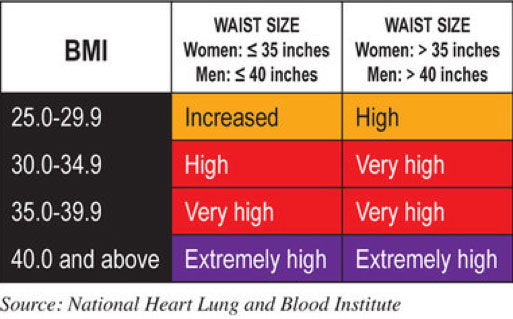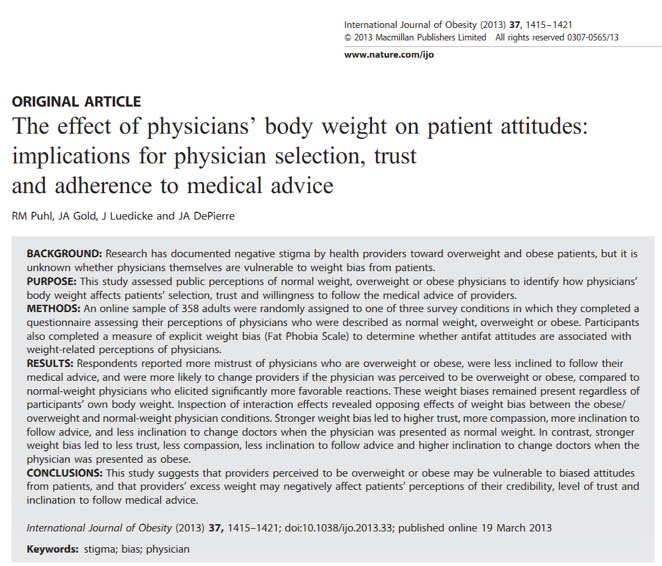There are numerous published articles discussing your waist circumference and it is associated with adverse health conditions.
First, how do you correctly measure your waist circumference?
- Stand and place a tape measure around your bare stomach, just above your hip bones.
- Pull the tape measure until it fits snugly around you, but does not push into your skin. Make sure the tape measure is level all the way around.
- Relax, exhale and measure your waist, resisting the urge to suck in your stomach.
What numbers are associated with risk of adverse medical conditions?
Measuring waist circumference helps screen for possible health risks that come with overweight and obesity. If most of your fat is around your waist rather than at your hips, you are at a higher risk for heart disease and type-2 diabetes. This risk goes up with a waist size that is greater than 35 inches for women or greater than 40 inches for men.
(https://www.nhlbi.nih.gov/health/educational/lose_wt/risk.htm)

The male and female pictured above have a serious life-threatening problem. Unfortunately, most patients I see do not take it serious. Laughing they say, “I got a little belly fat, it’s that sweet tooth that runs in my family!” The most common remark I hear from men is, “Oh, that is just my beer belly, I can stop drinking anytime I want!”
This no laughing matter! I am talking about the quality and length of your life!
Look at the diagram below.

You can have a normal BMI (body mass index) and still be at high risk for metabolic disorders based on your waist circumference. Stop reading right now and find yourself a tape measure. Measure your waist circumference as I described above! The data below will hopefully convince you that you need to take action NOW!
A study from the Intermountain Medical Center Heart Institute in Salt Lake City and John Hopkins Hospital in Baltimore lends more evidence to the idea that it’s better to be shaped like a pear — with weight around the hips — as opposed to an apple — with weight around the abdomen.
Apple-shaped bodies are already associated with metabolic syndrome (which includes high blood pressure, high sugar levels and high cholesterol), as well as coronary artery disease and heart failure, but this study found that waist circumference is also a strong predictor of left ventricular dysfunction (heart disease) in patients. Metabolic syndrome is often accompanied by excess body fat around the waist. (https://www.sciencedaily.com/releases/2016/04/160402111232.htm)
Still not convinced that this is serious problem, keep on reading!
What is it about abdominal fat that makes it strong marker of disease risk? The fat surrounding the liver and other abdominal organs, so-called visceral fat, is very metabolically active. It releases fatty acids, inflammatory agents, and hormones that ultimately lead to higher LDL cholesterol, triglycerides, blood glucose, and blood pressure. Despres JP. Health consequences of visceral obesity. Ann Med. 2001;33:534-41.
Decades later, long-term follow-up studies showed that so-called “abdominal obesity” was strongly associated with an increased risk of type 2 diabetes, cardiovascular disease and death, even after controlling for body mass index (BMI). Ohlson LO, Larsson B, Svardsudd K, et al. The influence of body fat distribution on the incidence of diabetes mellitus. 13.5 years of follow-up of the participants in the study of men born in 1913. Diabetes. 1985;34:1055-8. Larsson B, Svardsudd K, Welin L, Wilhelmsen L, Bjorntorp P, Tibblin G. Abdominal adipose tissue distribution, obesity, and risk of cardiovascular disease and death: 13 year follow up of participants in the study of men born in 1913. Br Med J (Clin Res Ed). 1984;288:1401-4.
Increased risk of cardiovascular disease and death sounds pretty serious to me! What are you waiting for? Have you measured your waist circumference yet?
Hormones and Belly Fat
Hormone imbalance can contribute to belly fat:
High estrogen in men and women
Low progesterone in women
Low DHEA in men or women
High or low testosterone in men or women
High cortisol in men or women
Low growth hormone in men and women
Low thyroid in men and women
Elevated insulin levels in men and women
The key to hormone therapy is that it has to individualized, monitored carefully, and in perfect balance. The hormones must be bioidentical. It is like a symphony, if only one instrument is out of tune or if a clarinet is replaced by a trombone (not identical) the entire symphony will not sound the same!
Physicians and other health care providers have to maintain a normal waist size not only for their health, but the effect that their waist size has on their patients confidence in the advice they are giving to their patients. Look at the article below.
An article published in the International Journal of Obesity {(2013) 37, 1415-1421} Titled “The effect of physicians’ body weight on patient attitudes: implication of physician selection, trust, and adherence to medical advice” came to this conclusion, “This study suggests that providers perceived to be overweight or obese may be vulnerable to biased attitudes from patients, and the providers’ excess weight may negatively affect patient’s perceptions of their credibility, level of trust and inclination to follow medical advice.”
Physician first, heal thyself!
Age, genetics, and belly fat.
There are certain genes that you inherit that will increase your risk of weight gain, including belly fat. At my office we check for those genes with a test called, “Advanced Genomics Made Personal”. This is an amazing genetic test that informs you of what gene you inherited that affects how you metabolize fats, various beverages, vitamins, and what gene you have that may cause food cravings, addictive behavior, taste, sweet tooth, emotional eating, increased risk of obesity, what type of exercise is best for you, and much more. The results will allow us to develop an exercise and dietary program for you based on your genetics! The results have been amazing! If you are having difficulty losing weight, I encourage you to have this gene testing.
Alcohol’s calories contribute to beer belly
Drinking excess alcohol can cause you to gain belly fat — the beer belly. However, beer alone isn’t to blame. Drinking too much alcohol of any kind can increase belly fat, because alcohol contains calories. Although some research suggests wine might be an exception, if you drink alcohol, do so only in moderation.
For men age 65 and younger, moderation means up to two drinks a day. For men older than age 65, it means up to one drink a day. The less you drink, the fewer calories you’ll consume and the less likely you’ll be to gain belly fat.
(https://www.mayoclinic.org/healthy-lifestyle/mens-health/in-depth/belly-fat/art-20045685)
Weight loss and exercise will decrease your abdominal circumference
Aerobic and strength training exercises are essential if you expect to decrease your belly fat.
“Plant Paradox” by Dr. Grundry is an excellent book regarding proper nutrition. I recommend that you read the book! Again, proper nutrition without hormone balance will produce less than an ideal outcome!
Losing belly fat is a marathon and not a sprint! You must have the discipline to continue your individualized program to achieve the desired results. Not only will you look and feel better, but you will decrease your risks of the adverse medical conditions discussed in the above text.
I hope I have presented adequate evidence that size does make a difference, especially the size of your waist circumference!

About the Author
Douglas C. Hall, M.D.
Dr. Douglas Hall, was born in Indianapolis, Indiana on Jan. 30, 1941. He received his BS and Doctor of Medicine at the University of Florida, training in obstetrics and gynecology. Dr. Hall has been in private practice since 1974 and currently has a large practice in Ocala, specializing in OB/GYN and Functional Medicine.


